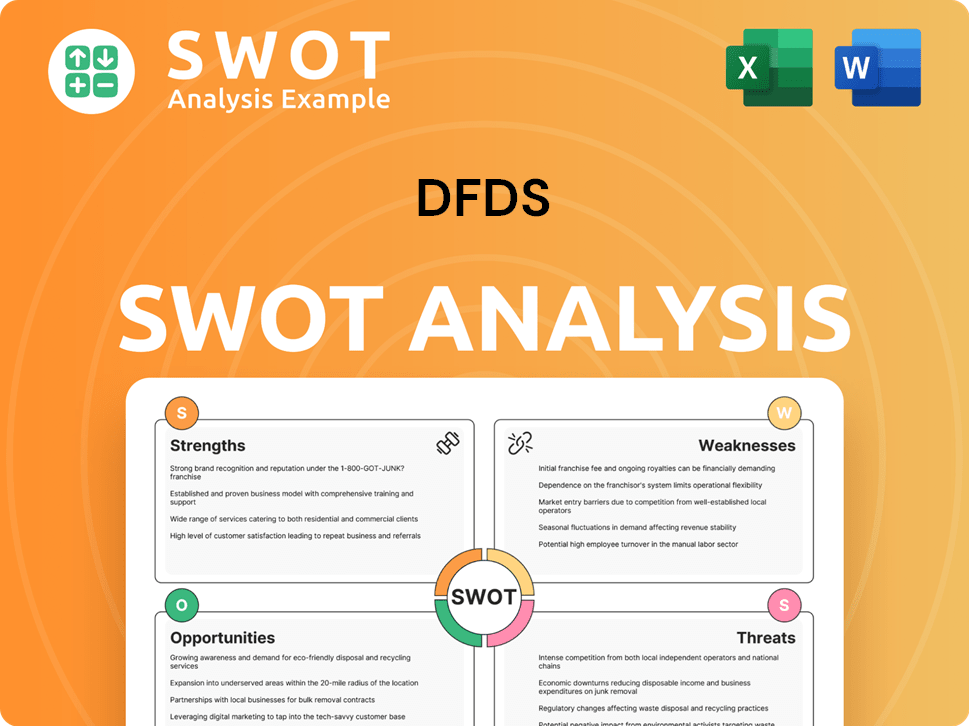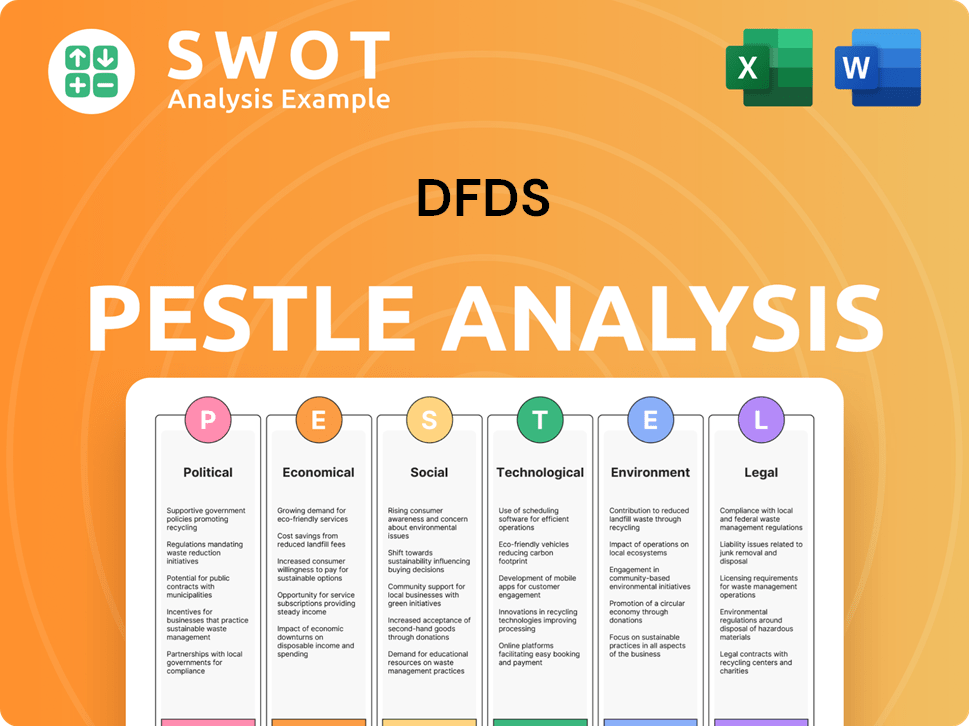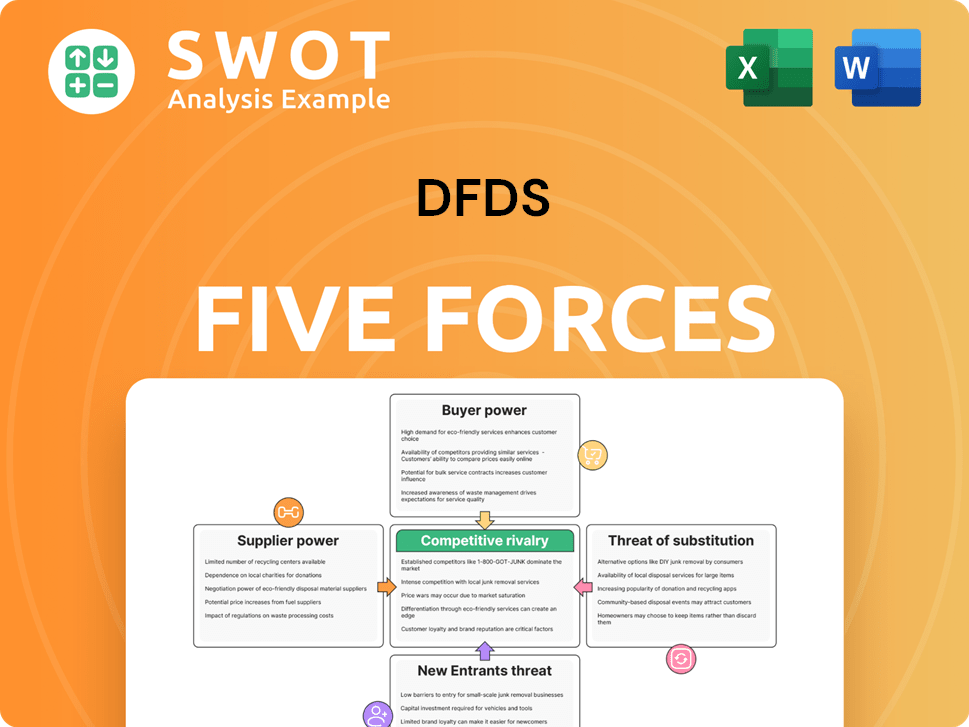DFDS Bundle
Can DFDS Navigate the Future of Shipping and Logistics?
DFDS, a titan in the European shipping and logistics sector since 1866, presents a compelling case study in strategic adaptation and growth. From its humble beginnings in Copenhagen, the company has evolved into a major player, boasting impressive DFDS SWOT Analysis. This analysis is crucial for understanding the company's trajectory. Today, with significant revenue and a vast network, DFDS's journey is a testament to its strategic foresight.

This exploration delves into the DFDS growth strategy, examining its historical acquisitions and future ambitions. We'll analyze the DFDS future prospects within the context of evolving market dynamics, evaluating its DFDS company analysis to understand its position in the DFDS shipping and DFDS logistics landscape. Key areas include DFDS financial performance, expansion plans, and sustainability initiatives, providing actionable insights for investors and industry observers alike.
How Is DFDS Expanding Its Reach?
The Brief History of DFDS reveals a company consistently focused on growth. DFDS's expansion initiatives are central to its strategy, targeting both geographical diversification and service optimization. These efforts are designed to enhance the company's market position and drive future financial performance.
DFDS is actively pursuing several strategies to expand its business. A key aspect of its growth strategy involves entering new geographical markets and enhancing connectivity. This includes strategic acquisitions and the securing of long-term contracts to strengthen its presence in key regions.
The company's focus on optimizing its service offerings and business models is another critical element. This involves adapting to changing market conditions, streamlining operations, and implementing initiatives to improve profitability. These efforts are expected to contribute to a more robust financial outlook.
DFDS is expanding its geographical footprint through strategic acquisitions and contract wins. In March 2025, DFDS secured a 20-year concession for Jersey ferry services, strengthening its position in the English Channel. This move is part of a broader strategy to enhance connectivity and access new markets.
Acquisitions are a significant part of DFDS's expansion plans. The acquisition of FRS Iberia/Maroc and Ekol International Transport are prime examples. The Ekol International Transport acquisition, completed in November 2024, aims to expand the network and diversify revenue streams, with a goal to reach breakeven by year-end 2025.
DFDS is focused on optimizing its service offerings to adapt to changing market dynamics. This includes adapting Mediterranean ferry operations and implementing logistics turnaround projects. These projects involve price adjustments, capacity changes, and cost-cutting measures to improve profitability.
Management anticipates a more visible earnings recovery from Q2 2025 onwards, driven by these initiatives. The goal to reach breakeven by year-end 2025 for acquisitions like Ekol International Transport highlights the company's commitment to achieving financial targets. These efforts are designed to drive DFDS's financial performance.
DFDS's expansion strategy includes geographical expansion, strategic acquisitions, and service optimization. These initiatives are designed to drive revenue growth and enhance market share. The company is focused on improving operational efficiency and adapting to market changes.
- Entering new geographical markets to increase its footprint.
- Acquiring companies to expand its network and diversify revenue streams.
- Optimizing service offerings to adapt to a changing competitive environment.
- Implementing logistics turnaround projects to improve profitability.
DFDS SWOT Analysis
- Complete SWOT Breakdown
- Fully Customizable
- Editable in Excel & Word
- Professional Formatting
- Investor-Ready Format

How Does DFDS Invest in Innovation?
The company is actively leveraging technology and innovation to drive sustained growth and improve operational efficiency. This commitment to digital transformation is significantly impacting its operations and boosting customer satisfaction. The company is focused on digitizing core operations and launching new digital and online services to enhance its offerings and improve the customer experience.
A key component of their innovation strategy is a strong emphasis on sustainability and decarbonization. The company aims to significantly reduce its environmental impact through various initiatives.
The company's approach includes digitizing core operations, launching new digital services, and focusing on sustainability. These efforts are designed to enhance operational efficiency, improve customer satisfaction, and reduce environmental impact, contributing to the overall DFDS growth strategy.
The company is digitizing core operations and launching new digital services. This includes providing instant quotes for logistics customers. Data transparency across its network has improved decision-making and automation.
DFDS is committed to reducing Tank-to-Wake CO2 emissions intensity by 45% by 2030. The company aims for net-zero emissions by 2050 for vessel operations. For road and land transport, the goal is to reduce Well-to-Wheel CO2e emissions intensity by 75% by 2030, also aiming for net-zero by 2050.
The company is investing in more fuel-efficient vessels. It is exploring alternative fuels like electricity and green methanol. DFDS plans to build six ships powered by alternative fuels by 2030, focusing on electric, green methanol, and ammonia.
Since October 2024, DFDS and Volvo Trucks have collaborated to shift container traffic to overnight operations using heavy electric trucks. This initiative aims for emission-free transport to and from the Port of Antwerp, primarily during off-peak hours.
DFDS is working towards a 25% reduction in food waste by 2025 compared to 2023 levels. This includes menu optimization, food waste tracking, and creative repurposing.
These innovations and sustainability efforts are critical to the company's long-term success. They contribute to the mission, vision, and core values of DFDS, enhancing its competitive position in the DFDS shipping and DFDS logistics sectors.
These initiatives are central to the company's long-term goals and contribute to its financial performance. The company's focus on digital transformation and sustainability positions it well within the DFDS competitive landscape and supports its DFDS future prospects.
The company's innovation strategy is multifaceted, focusing on digital solutions and environmental sustainability. These initiatives are designed to improve operational efficiency, enhance customer satisfaction, and reduce the environmental impact of its operations. The company's commitment to reducing emissions and adopting new technologies underscores its dedication to long-term sustainability and value creation.
- Digitalization of core operations for improved efficiency.
- Investment in fuel-efficient vessels and alternative fuels.
- Collaboration with Volvo Trucks for emission-free transport.
- Targeted food waste reduction by 25% by 2025.
- Focus on reducing CO2 emissions across all operations.
DFDS PESTLE Analysis
- Covers All 6 PESTLE Categories
- No Research Needed – Save Hours of Work
- Built by Experts, Trusted by Consultants
- Instant Download, Ready to Use
- 100% Editable, Fully Customizable

What Is DFDS’s Growth Forecast?
The financial outlook for DFDS in 2025 indicates a period of transition, with a focus on improving profitability after a challenging 2024. In 2024, DFDS experienced a 9% increase in revenue, reaching DKK 29.8 billion, but faced a 35% decrease in earnings before interest and taxes (EBIT), which fell to DKK 1.5 billion. Adjusted free cash flow for the year was DKK 1.0 billion.
For 2025, DFDS anticipates a revenue growth of approximately 5%. The company expects both EBIT and adjusted free cash flow to be around DKK 1.0 billion. This forecast includes significant negative impacts on earnings due to changes in the competitive environment within the Mediterranean ferry network and the integration of the newly acquired Türkiye & Europe South business area (formerly Ekol International Transport).
The Logistics Division's EBIT outlook was revised downward to DKK 0.2 billion from DKK 0.3 billion, while the Ferry Division's EBIT outlook was raised to DKK 1.0 billion from DKK 0.9 billion. DFDS is prioritizing deleveraging its capital structure in 2025 and has proposed no capital distribution to shareholders to support this objective. The company's financial ambitions for ROIC, adjusted free cash flow, and financial leverage set for 2026/27 are no longer applicable due to the earnings development in 2024 and 2025. Despite these challenges, DFDS anticipates its financial solidity will strengthen in the second half of 2025 as earnings improve and net interest-bearing debt decreases.
In 2024, DFDS saw a revenue increase of 9% to DKK 29.8 billion. However, EBIT decreased by 35% to DKK 1.5 billion. The company's 2025 forecast includes a revenue growth of around 5% with EBIT and adjusted free cash flow expected to be around DKK 1.0 billion.
The integration of the Türkiye & Europe South business area is expected to negatively impact EBIT in 2025. Changes in the competitive landscape in the Mediterranean ferry network also present challenges. The Logistics Division's EBIT outlook was lowered, while the Ferry Division's outlook was raised.
DFDS is focused on deleveraging its capital structure in 2025, with no capital distribution planned. The company's financial goals for 2026/27 are under review due to recent earnings performance. DFDS anticipates improved financial solidity in the second half of 2025.
The Ferry Division is expected to perform better, with an increased EBIT outlook. The Logistics Division's EBIT outlook has been adjusted downwards. These shifts reflect strategic adjustments and market dynamics within each sector.
The decision to forgo capital distribution to shareholders in 2025 underscores the company's commitment to strengthening its financial position. This move supports the strategic goal of reducing debt and improving overall financial health.
The adjustments to financial ambitions for 2026/27 highlight the dynamic nature of the business environment. The company is adapting its long-term strategy based on current market conditions and performance.
DFDS Business Model Canvas
- Complete 9-Block Business Model Canvas
- Effortlessly Communicate Your Business Strategy
- Investor-Ready BMC Format
- 100% Editable and Customizable
- Clear and Structured Layout

What Risks Could Slow DFDS’s Growth?
The path for Owners & Shareholders of DFDS towards growth is not without its hurdles. The company faces a complex web of challenges that could potentially hinder its ambitious expansion plans and impact its financial performance. Understanding these risks is crucial for assessing the overall investment opportunities associated with DFDS's future.
One of the primary concerns is the fierce competition within the shipping industry, particularly in the Mediterranean. This intense rivalry, coupled with overcapacity, has led to pricing pressures that directly affect DFDS's profitability. Furthermore, the successful financial turnaround of recent acquisitions, such as the Ekol International Transport (now Türkiye & Europe South business area), is critical for achieving the company's financial targets.
External factors also pose significant threats to DFDS's operations and growth trajectory. Economic uncertainties, geopolitical instability, and supply chain disruptions add layers of complexity to the business environment. These challenges necessitate proactive risk management and strategic adaptation to ensure long-term sustainability and success.
Intense competition, especially in the Mediterranean, impacts DFDS's DFDS shipping and ferry operations. Overcapacity in the market has led to pricing challenges, affecting revenue and profitability. This competitive landscape necessitates strategic adjustments to maintain market share and financial health.
The financial performance of acquired businesses, such as the Türkiye & Europe South business area, is a key factor. Successfully integrating and turning around these operations is essential for achieving overall financial goals. The company aims to reach breakeven for this division by the end of 2025.
Muted European economic growth and potential recession risks pose significant challenges. Geopolitical tensions, particularly in regions like Ukraine and Türkiye, can disrupt trade flows. These external factors require DFDS to adapt its strategies and operations to mitigate potential impacts.
Disruptions in supply chains, particularly in sectors like meat export and automotive, remain a concern. These vulnerabilities can impact DFDS's DFDS logistics services and overall operational efficiency. Addressing these issues requires proactive measures and diversified strategies.
While management is confident in overcoming these challenges, execution risks persist. Successfully implementing restructuring programs, adapting to market changes, and achieving organic growth targets require effective management and strategic execution. The company's ability to navigate these risks will determine its future success.
Fluctuations in fuel prices can significantly affect DFDS's operational costs and profitability. Managing fuel expenses through hedging strategies and efficient operations is crucial for maintaining financial stability. The impact of fuel prices is a key consideration for DFDS financial performance.
DFDS is adapting its Mediterranean network to address competitive pressures. The company is also focusing on turning around its logistics operations and pursuing organic growth opportunities. Prioritizing deleveraging its capital structure to enhance financial flexibility is also a key strategy.
Adapting to the changing competitive environment, executing turnarounds, and focusing on organic growth are key. The company is also prioritizing deleveraging its capital structure to enhance financial flexibility. These strategies are essential for addressing the challenges and achieving long-term goals.
DFDS Porter's Five Forces Analysis
- Covers All 5 Competitive Forces in Detail
- Structured for Consultants, Students, and Founders
- 100% Editable in Microsoft Word & Excel
- Instant Digital Download – Use Immediately
- Compatible with Mac & PC – Fully Unlocked

Related Blogs
- What are Mission Vision & Core Values of DFDS Company?
- What is Competitive Landscape of DFDS Company?
- How Does DFDS Company Work?
- What is Sales and Marketing Strategy of DFDS Company?
- What is Brief History of DFDS Company?
- Who Owns DFDS Company?
- What is Customer Demographics and Target Market of DFDS Company?
Disclaimer
All information, articles, and product details provided on this website are for general informational and educational purposes only. We do not claim any ownership over, nor do we intend to infringe upon, any trademarks, copyrights, logos, brand names, or other intellectual property mentioned or depicted on this site. Such intellectual property remains the property of its respective owners, and any references here are made solely for identification or informational purposes, without implying any affiliation, endorsement, or partnership.
We make no representations or warranties, express or implied, regarding the accuracy, completeness, or suitability of any content or products presented. Nothing on this website should be construed as legal, tax, investment, financial, medical, or other professional advice. In addition, no part of this site—including articles or product references—constitutes a solicitation, recommendation, endorsement, advertisement, or offer to buy or sell any securities, franchises, or other financial instruments, particularly in jurisdictions where such activity would be unlawful.
All content is of a general nature and may not address the specific circumstances of any individual or entity. It is not a substitute for professional advice or services. Any actions you take based on the information provided here are strictly at your own risk. You accept full responsibility for any decisions or outcomes arising from your use of this website and agree to release us from any liability in connection with your use of, or reliance upon, the content or products found herein.